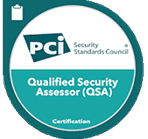Payment Card Industry Data Security Standard 4.0 (PCI DSS 4.0), released in March 2022, introduced significant changes to the standard aimed at enhancing cardholder data security. These changes have a substantial impact on business compliance efforts.
Key Impacts of PCI DSS 4.0
Increased Focus on Cybersecurity Best Practices
PCI DSS 4.0 enhances cybersecurity practice by streamlining the security process with framework alignment and a risk-based approach to managing cyberthreats. Framework alignment refers to the effort to bring PCI more in line with other frameworks such as NIST CSF and ISO 27001, thus reducing the burden of maintaining multiple compliance standards for your organization.
The new PCI DSS 4.0 allows a certain amount of tailoring around your business’s cybersecurity stance with a risk-based approach. This allows you to prioritize security measures based on your specific vulnerabilities and risk profile. For instance, a physical store with card readers that directly transmit CHD to payment processors and utilizes a third-party payment application to meet PCI requirements versus an e-commerce website with custom software that stores and transmits CHD.
Enhanced Cloud Security Requirements
The dominance of cloud-based computing and IT solutions shifts 4.0’s focus to cloud-specific controls. The new version of PCI DSS compliance includes specific controls for cloud environments, addressing challenges related to shared responsibility models and data sovereignty.
Another enhancement for cloud security requirements is third-party assurance: Businesses are required to ensure that their cloud service providers have appropriate security controls in place and are subject to third-party assessments. This puts more pressure on third-party vendors to be “good actors” when it comes to cybersecurity, reducing your business’s exposure to threats that could be beyond your control.
Strengthened Data Protection Measures
Data segmentation requirements for PCI DSS 4.0 mandates collected data be segmented to limit the scope of potential data breaches. Segmentation reduces the amount and quality of data that can be captured in a cyber-attack.
The revised PCI DSS covers encryption at rest and in transit. Again, the updated requirement minimizes the exposure of PCI data by mandating encryption of cardholder data both at rest and in transit.
Building on segmentation, data minimization encourages businesses to minimize the amount of cardholder data they collect and retain, minimizing the exposure of critical information. For example, before the update a business could collect:
- Full cardholder name, including middle name
- Full credit card number
- Expiration date
- Additional data that can be seen as unnecessary such as cardholder address, phone number, and email address
Following the introduction of PCI DSS 4.0’s data minimization suggestions a business should collect a streamlined profile:
- Only the first and last name of the cardholder
- Partial card number (last 4 digits)
- Expiration date, but only stored for the duration of the transaction
- No additional data
Expanded Security Controls
Security controls have grown under PCI DSS 4.0 to include vulnerability management, logging and monitoring, and application security. Businesses are now required to have a formal vulnerability management program in place. Enhanced logging and monitoring requirements such as system access, application activity, and security event logging aim to improve detection and response to security incidents.
The PCI DSS compliance standard now includes specific requirements for application security, such as secure coding practices and vulnerability scanning.
Impact of PCI DSS on Various Business Verticals
The PCI DSS had a significant impact on businesses across various verticals. Here’s a breakdown of how it has affected different industries:
Retail
- Point-of-Sale (POS) Systems: Retail businesses have had to invest in secure POS systems and implement robust security measures to protect cardholder data.
- Data Breach Costs: Data breaches can be extremely costly for retailers, both in terms of financial penalties and damage to reputation. Adherence to PCI DSS can help mitigate these risks.
- Customer Trust: PCI DSS compliance can help build customer trust and confidence in a retailer’s ability to protect their sensitive information.
E-commerce
- Online Retailers: E-commerce businesses must have secure websites and payment processing systems to protect cardholder data.
- Data Breaches: E-commerce businesses are particularly vulnerable to data breaches. Compliance with PCI DSS can help mitigate this risk.
- Customer Confidence: A PCI DSS-compliant e-commerce website can help build customer confidence and encourage online purchases.
Hospitality
- Hotel Reservations: Hotels often handle cardholder data during the booking process. Compliance with PCI DSS is essential to protect this sensitive information.
- Restaurant Transactions: Restaurants must ensure that their POS systems and payment processing procedures are PCI DSS compliant.
- Guest Data: Hotels and restaurants may also store guest data, such as addresses and contact information. This data must be protected in accordance with PCI DSS requirements.
Healthcare
- Medical Billing: Healthcare providers often handle cardholder data for medical billing purposes. Compliance with PCI DSS is crucial to protect patient privacy and prevent data breaches.
- Electronic Health Records (EHRs): EHR systems may store cardholder data, making it essential for healthcare organizations to implement appropriate security measures.
- HIPAA Compliance: PCI DSS compliance can often overlap with Health Insurance Portability and Accountability Act (HIPAA) requirements, simplifying compliance efforts for healthcare organizations.
Financial Services
- Banks and Credit Unions: Financial institutions are subject to strict PCI DSS requirements to protect cardholder data.
- Payment Processors: Payment processors play a critical role in card transactions and must ensure compliance with PCI DSS.
- ATM Networks: ATM networks handle large amounts of cardholder data and must implement robust security measures to protect it.
Other Business Verticals
- Non-Profit Organizations: Non-profits that accept donations by credit card must comply with PCI DSS.
- Government Agencies: Government agencies that handle cardholder data, such as those that collect taxes or fees, are subject to PCI DSS requirements.
- Small Businesses: Even small businesses can be impacted by PCI DSS if they accept card payments.
Business Challenges for PCI DSS 4.0 Transition
The evolving landscape of cybersecurity and compliance always presents challenges for IT and security teams trying to remain current and in front of looming cybersecurity threats. PCI DSS 4.0 is no different with these familiar hurdles to clear:
- Compliance Deadlines: Businesses have a specific timeline to achieve compliance with PCI DSS 4.0.
- Gap Assessments: Conducting thorough gap assessments to identify areas where existing security measures may not meet the new requirements.
- Resource Allocation: Allocating sufficient resources for compliance efforts, including personnel, technology, and budget.
Overall, PCI DSS 4.0 represents a significant step forward in cardholder data security. While it introduces additional requirements, it also aligns with broader cybersecurity best practices and provides a more risk-based approach. Businesses across various verticals that can successfully adapt to these changes will be better positioned to protect cardholder data, mitigate the costly risks associated with data breaches, and build trust with customers and organizational leadership.








